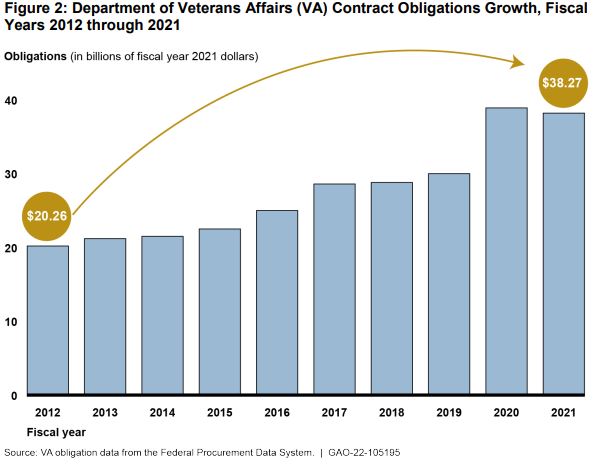WASHINGTON, DC — For the past decade, VA has struggled to implement a standardized framework for how it purchases goods and services. The lack of one has resulted in the department being unable to provide proper oversight of major projects, sometimes resulting in inaccurate estimates for how much those projects will cost in the long run.
When VA attempted to adopt such a system in 2017, it went mostly ignored by VA offices, which preferred to use program-specific approaches that varied widely in effectiveness.
VA has plans to implement a new acquisitions framework this year, but according to the Government Accountability Office (GAO) the department still has not addressed the problems that caused the last one to so swiftly fail.
Over the past decade, VA’s contract obligations have doubled in size to $38 billion as of 2021. GAO added VA’s acquisition management to its High-Risk List in 2019 due to numerous challenges to efficiently purchase goods and services, including medical supplies.
One of the problems identified by GAO was the lack of a clear acquisitions framework—a system for understanding what a project needs and determining the best way to go about purchasing it. A good framework identifies and validates needs; assesses alternative solutions; establishes well-defined requirements; develops realistic cost estimates and schedules; and uses milestones and exit criteria to determine when a project is complete.
Without being able to answer those kinds of questions, programs can more easily go over in cost, miss deadlines and hit roadblocks that could have been avoided if alternatives solutions had been considered.
VA’s electronic health records system program is a good example of this, GAO investigators noted. In July 2021, the VA Inspector General reported that VA’s cost estimates for the program were unreliable, underreporting the program’s life-cycle costs by at least $2.5 billion.
During the course of several recent congressional hearings on floundering projects, including the EHR, lawmakers have asked VA officials why the department didn’t consider alternatives before choosing a particular course, something an acquisitions framework would have required the department to do.
No Uniform System
In 2017, VA began using the Acquisition Program Management Framework (APMF). However, most program offices for major acquisitions never adopted it. Instead, they relied on program-specific approaches that varied from office to office, making it a challenge for VA to provide any kind of uniform oversight for acquisitions.
“The robustness of those program-specific approaches varied widely,” the GAO noted in its report. “For example, when VA acquired a new supply chain IT platform—Defense Medical Logistics Standard Support (DMLSS)—it did not use a rigorous process to identify operational needs. … Consequently, not only has DMLSS been delayed, but [it] was ultimately found to not meet 44% of high-priority requirements for daily operation at the VA medical center where it was piloted.”
Because of a lack of national oversight, it was not until two years after APMF’s implementation that VA realized that its offices were not using the new system.
Now, VA is looking to implement the Acquisition Lifecycle Framework (ALF) to replace APMF. However, according to GAO, the department has yet to fully grapple with the reasons the previous framework failed, making it likely that they’ll repeat some of the same mistakes.
A key concern for GAO is that VA has not developed a plan to measure the use of the proposed framework or a mechanism to ensure that VA offices comply with the program.
There is also no good way for the department to determine which programs require additional oversight due to their size and cost, since VA’s methods for estimating a program’s total cost are flawed, the report states.
“VA’s Senior Procurement Executive said that identifying relevant acquisition programs and their related costs is challenging due to major gaps in program data and a lack of uniform standards in how programs currently report such data,” the investigators wrote.
VA also needs to assess what, if any, additional workforce it will need to bring on to make sure ALF is successful.
“When implementing APMF, VA did not account for a shortfall of program personnel, which hindered the program’s adoptions,” the GAO investigators wrote. “[VA] has yet to assess whether the issue still exists and whether it will affect plans for implementing its proposed framework.”


